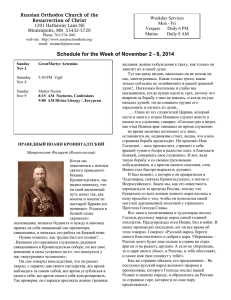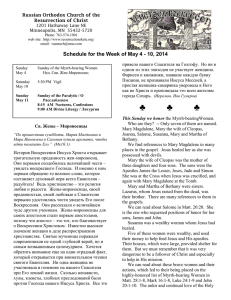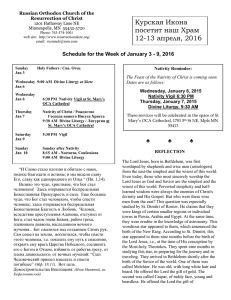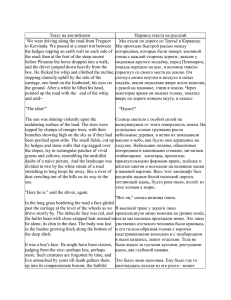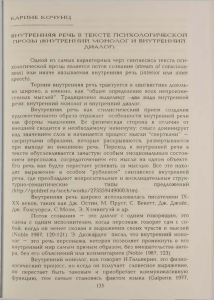Восхождение Монолог об Аароне Априле
реклама
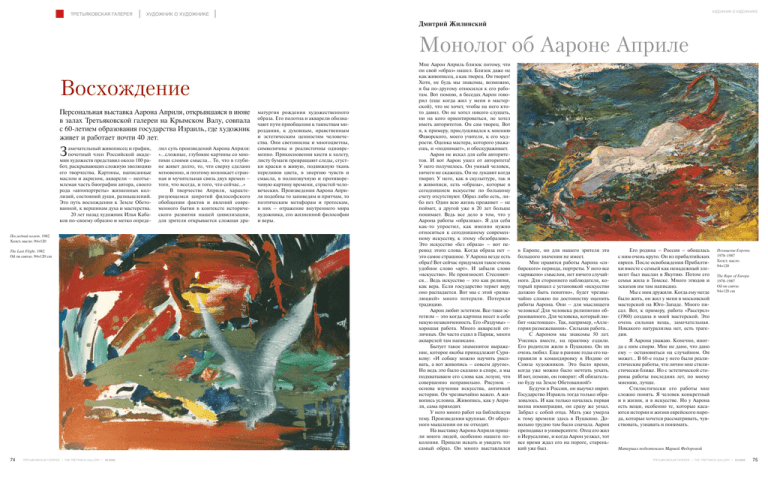
ТРЕТЬЯКОВСКАЯ ГАЛЕРЕЯ ХУДОЖНИК О ХУДОЖНИКЕ ХУДОЖНИК О ХУДОЖНИКЕ Дмитрий Жилинский Монолог об Аароне Априле Восхождение Персональная выставка Аарона Априля, открывшаяся в июне в залах Третьяковской галереи на Крымском Валу, совпала с 60-летием образования государства Израиль, где художник живет и работает почти 40 лет. З амечательный живописец и график, почетный член Российской aкадемии художеств представил около 100 работ, раскрывающих сложную эволюцию его творчества. Картины, написанные маслом и акрилом, акварели – неотъемлемая часть биографии автора, своего рода «автопортреты» жизненных коллизий, состояний души, размышлений. Это путь восхождения к Земле Обетованной, к вершинам духа и мастерства. 20 лет назад художник Илья Кабаков по-своему образно и метко опредеПоследний полет. 1982 Холст, масло. 94×120 The Last Flight. 1982 Oil on canvas. 94×120 cm 74 ТРЕТЬЯКОВСКАЯ ГАЛЕРЕЯ / THE TRETYAKOV GALLERY / #2’2008 лил суть произведений Аарона Априля: «...сложные, глубокие картины со многими слоями смысла… То, что в глубине живет долго, то, что сверху сделано мгновенно, и поэтому возникает странная и мучительная связь двух времен – того, что всегда, и того, что сейчас…» В творчестве Априля, характеризующемся широтой философского обобщения фактов и явлений современного бытия в контексте исторического развития нашей цивилизации, для зрителя открывается сложная дра- матургия рождения художественного образа. Его полотна и акварели обозначают пути приобщения к таинствам мироздания, к духовным, нравственным и эстетическим ценностям человечества. Они светоносны и многоцветны, символичны и реалистичны одновременно. Прикосновения кисти к холсту, листу бумаги превращают следы, сгустки краски в живую, подвижную ткань переливов цвета, в энергию чувств и смысла, в полнозвучную и противоречивую картину времени, страстей человеческих. Произведения Аарона Априля подобны то заповедям и притчам, то поэтическим метафорам и гротескам, в них – отражение внутреннего мира художника, его жизненной философии и веры. Мне Аарон Априль близок потому, что он свой «образ» нашел. Близок даже не как живописец, а как творец. Он творит! Хотя, не будь мы знакомы, возможно, я бы по-другому относился к его работам. Вот помню, в беседах Аарон говорил (еще когда жил у меня в мастерской), что не хочет, чтобы на него ктото давил. Он не хотел никого слушать, ни на кого ориентироваться, не хотел иметь авторитетов. Он сам творец. Вот я, к примеру, прислушивался к мнению Фаворского, моего учителя, к его мудрости. Оценка мастера, которого уважаешь, и «поднимает», и обескураживает. Аарон не искал для себя авторитетов. И вот Аарон ушел от авторитета! У него получилось. Он умный человек, ничего не скажешь. Он не лукавит когда творит. У него, как в скульптуре, так и в живописи, есть «образы», которые в сегодняшнем искусстве по большому счету отсутствуют. Образ либо есть, либо нет. Один всю жизнь проживет – не поймет, а другой уже в 20 лет больше понимает. Ведь все дело в том, что у Аарона работы «образные». Я для себя как-то упростил, как именно нужно относиться к сегодняшнему современному искусству, к этому «безобразию». Это искусство «без образа» – вот перевод этого слова. Когда образа нет – это самое страшное. У Аарона везде есть образ! Вот сейчас придумали такое очень удобное слово «арт». И забыли слово «искусство». Не произносят. Стесняются… Ведь искусство – это как религия, как вера. Если государство теряет веру оно распадается. Вот мы с этой «развалюцией» много потеряли. Потеряли традицию. Аарон любит эстетизм. Все-таки эстетизм – это когда картина несет в себе некую незаконченность. Его «Раздумье» – хорошая работа. Много акварелей отличных. Он часто ездил в Париж, много акварелей там написано. Бытует такое знаменитое выражение, которое якобы принадлежит Сурикову: «И собаку можно научить рисовать, а вот живопись – совсем другое». Но ведь это было сказано в споре, а мы подхватываем его слова как лозунг, что совершенно неправильно. Рисунок – основа изучения искусства, античной истории. Он чрезвычайно важен. А живопись условна. Живопись, как у Априля, сама приходит. У него много работ на библейскую тему. Произведения крупные. От образного мышления он не отходит. На выставку Аарона Априля пришли много людей, особенно нашего поколения. Пришли искать и увидеть тот самый образ. Он много выставлялся в Европе, но для нашего зрителя это большого значения не имеет. Мне нравятся работы Аарона «сибирского» периода, портреты. У него все «заряжено» смыслом, нет ничего случайного. Для стороннего наблюдателя, который пришел с установкой «искусство должно быть понятно», будет чрезвычайно сложно по достоинству оценить работы Аарона. Они – для мыслящего человека! Для человека религиозно образованного. Для человека, который любит «настоящее». Так, например, «Аллегория размежевания». Сильная работа… С Аароном мы знакомы 50 лет. Учились вместе, на практику ездили. Его родители жили в Пушкино. Он их очень любил. Еще в ранние годы его направили в командировку в Индию от Союза художников. Это было время, когда уже можно было мечтать уехать. И вот, помню, он говорит: «Я обязательно буду на Земле Обетованной!» Будучи в России, он выучил иврит. Государство Израиль тогда только образовалось. И как только началась первая волна иммиграции, он сразу же уехал. Забрал с собой отца. Мать уже умерла к тому времени здесь в Пушкино. Довольно трудно там было сначала. Аарон преподавал в университете. Отец его жил в Иерусалиме, и когда Аарон уезжал, тот все время ждал его на пороге, старенький уже был. Его родина – Россия – обошлась с ним очень круто. Он из прибалтийских евреев. После освобождения Прибалтики вместе с семьей как ненадежный элемент был выслан в Якутию. Потом его семья жила в Томске. Много этюдов и эскизов им там написано. Мы с ним дружили. Когда ему негде было жить, он жил у меня в московской мастерской на Юго-Западе. Много писал. Вот, к примеру, работа «Расстрел» (1960) создана в моей мастерской. Это очень сильная вещь, замечательная. Никакого натурализма нет, есть трагедия. Я Аарона уважаю. Конечно, иногда с ним спорю. Мне не дано, что дано ему – остановиться на случайном. Он может… В 60-е годы у него были реалистические работы, что лично мне стилистически ближе. Но с эстетической стороны работы последних лет, по моему мнению, лучше. Стилистически его работы мне сложно понять. Я человек конкретный и в жизни, и в искусстве. Но у Аарона есть вещи, особенно те, которые касаются истории и жизни еврейского народа, которые хочется рассматривать, чувствовать, узнавать и понимать. Похищение Европы 1978–1987 Холст, масло. 94×120 The Rape of Europa 1978–1987 Oil on canvas 94×120 cm Материал подготовлен Марией Федоровой ТРЕТЬЯКОВСКАЯ ГАЛЕРЕЯ / THE TRETYAKOV GALLERY / #2’2008 75 THE TRETYAKOV GALLERY ARTISTS ON ARTISTS ARTISTS ON ARTISTS Dmitry Zhilinsky A Monologue about Aaron April A Feeling of Ascension The solo exhibition of Aaron April at the Tretyakov Gallery coincided with the 60th anniversary of the foundation of the State of Israel, where the artist has been living and working for nearly 40 years. A superb painter and graphic artist and an honorary member of the Russian Academy of Fine Arts, April presented works highlighting the complex evolution of his art. His oil and acrylic paintings and watercolours are a key part of the artist’s biography, “self-portraits” of sorts, witness to the conflicts he has experienced in his lifetime, to his states of mind and reflections. It documents an uphill path to be ascended to reach the “Promised Land”, and the heights of spirit and craftsmanship. Женщины слушают пение Давида. 2006 Бумага, акварель 23×34 Women Listening to David Singing. 2006 Watercolour on paper 23×34 cm 76 ТРЕТЬЯКОВСКАЯ ГАЛЕРЕЯ / THE TRETYAKOV GALLERY / #2’2008 20 years ago Ilya Kabakov in his distinctive style imaginatively and aptly summarized the essence of April’s art: “…Complex, profound pictures with many layers of meaning … That which is at the depth lives long and that which is on the surface has been created instantaneously and this is the reason why the strange and painful link forms itself between the two varieties of time, the one that is forever and the one that is today…” Aaron April’s art, which in a comprehensive philosophical fashion synthesizes present-day realities in the context of the historical development of our civilization, presents to the viewer a complex narrative of the birth of the artistic image. His paintings and watercolours trace paths that unite one with the mysteries of the universe, and the spiritual, moral and aesthetic values of humankind. They are luciferous and multicoloured, symbolical and realistic at once. The brush touching a canvas or paper turns the traces, the clots of paint into a living, fluid fabric sparkling with colours, into an energy of feelings and meaning, into a full-voiced and selfcontradictory picture of the time and human passions. April’s works sometimes resemble commandments and parables, at other times, metaphors and grotesques; they reflect the artist’s inner world, his philosophy of life, his credo. I feel a closeness to Aaron April because he found his “image”. I feel a closeness not to the painter even, but to the creator. He creates things! Although, had we not known each other personally, I would probably think differently about his works. I remember when we talked Aaron mentioned (that was back when he lived in my studio) that he didn’t like to be pressured. He didn’t want to listen to anybody, to look up to anybody, to take a leaf from anybody’s book. He himself is the creator. I, for one, used to listen to the advice of my teacher Vladimir Favorsky, to his words of wisdom. The judgment of a master whom you respect both “uplifts” and disheartens. Aaron was reluctant to take a leaf from anybody’s book. And he didn’t! He could get along without looking up to anyone. He is a very clever person, and there is no denying that. His art is free of guile. Both his sculptures and paintings have “images” which, to be honest, are absent from today’s art. Image is either present or absent. There are people for whom a whole life is not enough to understand, while some others grasp a lot at 20. The thing is that Aaron’s works “have images”. I figured out for myself how you should treat this modern art, this “imagelessness”. This is art “without image” – that is the translation of the word. The worst thing that can happen is that image is absent. But Aaron has image in all his works! Now they have coined a very convenient word, “art”. And forgot the [Russian] word “iskusstvo” (art). They never say it. They are ashamed to… For “iskusstvo” is like religion, like faith. If a state loses faith, it falls apart. We lost a lot with this “devolution”. We lost tradition. Aaron likes aestheticism. Whatever you say, aestheticism means a picture marked by some incompleteness. His “Reflection” is a good work. Lots of superb watercolours. He often traveled to Paris and made many watercolours there. Surikov is said to once have said, “Even a dog can be taught to paint, but the art of painting is something quite different”. But he said that in a dispute, whereas we pick it up as a slogan, which is utterly wrong. Drawing is the basis of the study of art and ancient history. Drawing is very important. Whereas the art of painting is relative. As in the case of April, it emerges by itself. April has many paintings focused on Biblical subjects. These are big pieces. He still sticks to image thinking. Many people, especially people of our generation, visited April’s show. They came to seek out and to see this image. April has often exhibited in Europe, but this does not mean much for our audience. I like Aaron’s “Siberian” pieces, his portraits. Everything in his art is charged with meaning; there is nothing accidental. A stranger whose sole idea about art is that “art must be comprehensible” will have difficulty giving Aaron’s art its due. His art is for people who think! For people educated in religion. For people who like “the present”. Take, for instance, the “Allegory of Dissociation.” A powerful piece… I have known Aaron for 50 years. We studied together, and traveled as interns together. His parents lived in Pushkino. He loved them a lot. When he was young still, he was sent to India by the Union of Artists. That was a time when it was possible already to dream of leaving Russia. And I remember him saying, “I swear I will come to the Promised Land!” In Russia he learned Hebrew. The state of Israel was only newly formed then. And no sooner had the first wave of immigration appeared than he left for Israel. He took his father with him. His mother had died by then, here in Pushkino. Over there, it was quite difficult at the beginning. Aaron did university teaching. His father lived in Jerusalem. And when Aaron left the house, his father, already an old man, would stay at the door waiting for him. His native country, Russia, treated him very harshly. He was descended from Baltic Jews. After the liberation of the Baltic states, he was exiled to Yakutia as a non-reliable individual. Later his family lived in Tomsk. He made many sketches and drafts there. We were friends. When he had nowhere to live, he lived in my studio in the Yugo-Zapadny district in Moscow. He painted a lot. For instance, “Execution” (1960) was created in my studio. This is a very powerful piece, a very good one. No naturalism, pure tragedy. I respect Aaron. Of course I argue with him sometimes. I do not have the faculty he has – that of dwelling on things accidental. He can do that… In the 1960s he produced realist pictures, which, stylistically, are something I feel closer to. But aesthetically, I believe, his recent works are the best. It is hard for me to understand his works stylistically. I have a materialistic set of mind in life as in art. But some of Aaron’s works, especially those focused on the history and life of the Jewish people – you want to look and look at them, to feel, to get to know and to understand them. Interview by Maria Fedorova Выход невесты 2004–2005 Бумага, акварель 70×90 The Appearance of the Bride 2004–2005 Watercolour on paper 70×90 cm Лот с дочерьми, IV 1993 Бумага, акварель 25×36 Lot and His Daughters, IV. 1993 Watercolour on paper 25×36 cm ТРЕТЬЯКОВСКАЯ ГАЛЕРЕЯ / THE TRETYAKOV GALLERY / #2’2008 77
